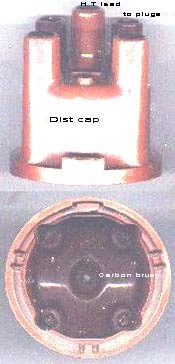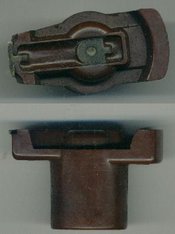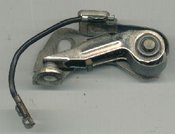
Distributor cap. At the center is a spring loaded carbon button that bears upon the rotor. The number of distribution points (in this case 4) is determined by the number of cylinders in the engine

Rotor. This rotates at the same speed as the camshaft, one half the speed of the crankshaft

Breaker arm with contact points at the left. The pivot is on the right and the cam follower is in the middle of the breaker arm.
The distributor in the ignition system of an internal combustion engine is a device which routes the high voltage in the correct firing order to the spark plugs.
Construction[]
It consists of a rotating arm or rotor inside the distributor cap, on top of the distributor shaft. The rotor contacts the central high voltage cable from the coil via a spring loaded carbon brush. The rotor arm passes close to (but does not touch) the output contacts which connect via high tension cables to the spark plug of each cylinder. Within the distributor, the high voltage energy is able to jump the small gap from the rotor arm to the contact.
The distributor shaft has a cam that operates the contact breaker. Opening the points causes a high induction voltage in the system's ignition coil.
The distributor also houses the centrifugal advance unit: a set of hinged weights attached to the distributor shaft, that cause the breaker points mounting plate to slightly rotate and advance the spark timing with higher engine rpm. In addition, the distributor has a vacuum advance unit that advances the timing even further as a function of the vacuum in the inlet manifold. Usually there is also a capacitor attached to the distributor. The capacitor is connected parallel to the breaker points, to suppress sparking and prevent wear of the points.
Improvements[]
Non contacting device[]
Around the 1970s the primary breaker points were largely replaced with Hall effect sensors. As this is a non-contacting device and the primary circuit is controlled by solid-state electronics, a great amount of maintenance in point adjustment and replacement was eliminated. This also eliminates any problem with breaker follower or cam wear, and by eliminating a side load extends distributor shaft bearing life. The remaining secondary (high voltage) circuit was as described above, using a single coil and a rotary distributor.
Direct ignition[]
Modern engine designs are tending to do away with the distributor and coil, instead performing the distribution function in the primary circuit electronically and applying the primary pulse to individual coils on top of each spark plug (Direct Ignition or coil-on-plug). This avoids the need to switch very high voltages, which is very often a source of trouble, especially in damp conditions.
Patents[]
- Template:US patent[1] - Ignition apparatus - Arthur Atwater Kent
- Template:US patent[2] - Ignition apparatus - Arthur Atwater Kent
- Template:US patent[3] - Ignition apparatus - Arthur Atwater Kent
- Template:US patent[4] - Ignition apparatus - Arthur Atwater Kent
- Template:US patent[5] - Ignition apparatus - Arthur Atwater Kent
- Template:US patent[6] - Ignition apparatus - Arthur Atwater Kent
- Template:US patent[7] - Ingnition system - Frank Conrad [8]
See also[]
| This page uses Creative Commons Licensed content from Wikipedia (view authors). | 
|